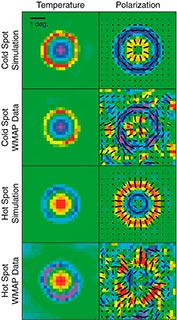
WMAP PRODUCES NEW RESULTS
WMAP 7-year Results Released - January 26, 2010
The WMAP team has reported the first direct detection of pre-stellar helium, providing an important test of the big bang prediction.
One of the key predictions of the hot big bang model is that most of the helium in the universe was synthesized in the hot early universe only a few minutes after the big bang. Previously, cosmologists studied old stars to infer the helium abundance before there were stars. WMAP data, in combination with smaller-scale data from the ACBAR and QUaD experiments, show the effects of helium in the microwave patterns on the sky indicating the presence of helium long before the first stars formed.
WMAP now places 50% tighter limits on the standard model of cosmology (Cold Dark Matter and a Cosmological Constant in a flat universe), and there is no compelling sign of deviations from this model.
WMAP has detected a key signature of inflation.
WMAP data place tight constraints on the hypothesized burst of growth in the first trillionth of a second of the universe, called "inflation", when ripples in the very fabric of space may have been created. The 7-year data provide compelling evidence that the large-scale fluctuations are slightly more intense than the small-scale ones, a subtle prediction of many inflation models.
WMAP strongly constrains dark energy and geometry of the universe.
The newly-released WMAP data are now sufficiently sensitive to test dark energy, providing important new information with no reliance on previous supernovae results. The combination of WMAP and other data** limits the extent to which dark energy deviates from Einstein's cosmological constant. The simplest model (a flat universe with a cosmological constant) fits the data remarkably well. The new data constrain the dark energy to be within 14% of the expected value for a cosmological constant, while the geometry must be flat to better than 1%. The simplest model: a flat universe with a cosmological constant, fits the data remarkably well.
In more technical terms, for a flat universe, the dark energy "equation of state" parameter is -1.1 ± 0.14, consistent with the cosmological constant (value of -1). If the dark energy is a cosmological constant, then these data constrain the curvature parameter to be within -0.77% and +0.31%, consistent with a flat universe (value of 0).
** Includes: the current expansion rate of the universe (the Hubble constant) and the large-scale galaxy distribution (the baryon acoustic oscillations).
WMAP places new constraints on the number of neutrino-like species in the early universe.
Neutrinos are nearly massless elementary particles that move at or near the speed of light. They permeate the universe in large quantity but they interact very weakly with atomic matter. Nonetheless they leave an imprint on the microwave fluctuations and the new WMAP data together with other data** show that the effective number of neutrino-like species is 4.34 ± 0.87. The standard model of particle physics has 3.04 effective species of neutrinos.
** Includes: the current expansion rate of the universe (the Hubble constant) and the large-scale galaxy distribution (the baryon acoustic oscillations).
WMAP has detected, with very high significance, temperature shifts induced by hot gas in galaxy clusters.
The CMB temperature in the direction of known galaxy clusters is expected to be slightly cooler than the average CMB temperature, due to interactions between CMB photons and the gas in the clusters. This effect has been observed in aggregate by WMAP and is consistent with analogous observations by the South Pole Telescope. Both observations are in conflict with extrapolated X-ray observations of clusters (X-rays probe a smaller volume of cluster gas than the CMB observations) and with numerical simulations, which must be missing some of the complex gas physics in the outer regions of the clusters.
WMAP has produced a visual demonstration that the polarization pattern around hot and cold spots follows the pattern expected in the standard model.
The standard model predicts a specific linked pattern of temperature and polarization around hot and cold spots in the map. WMAP now sees the predicted pattern in the map, as shown in the figure.

